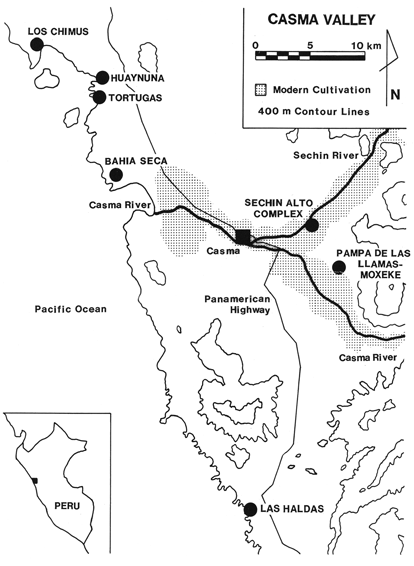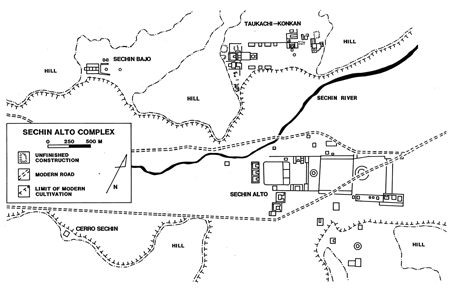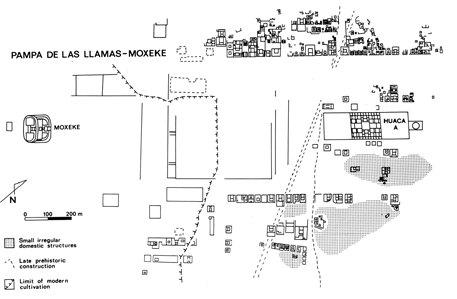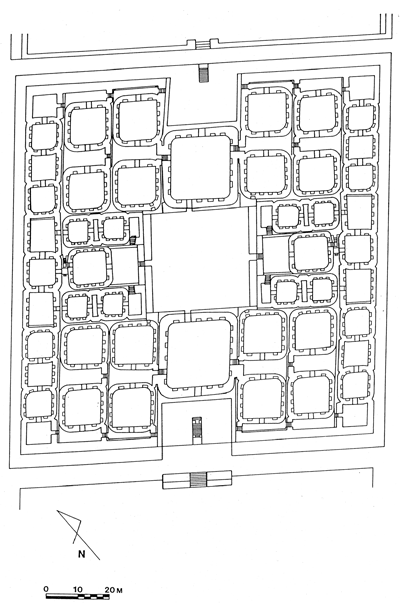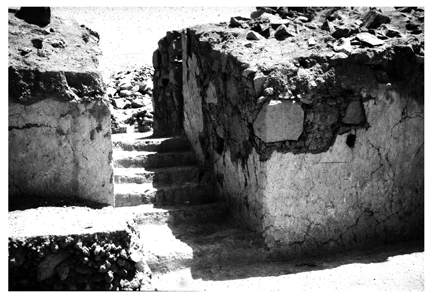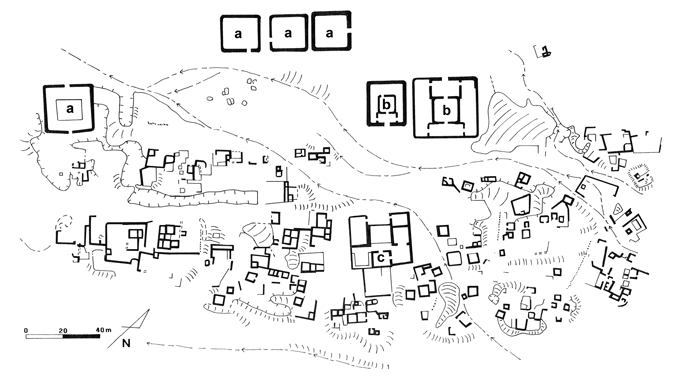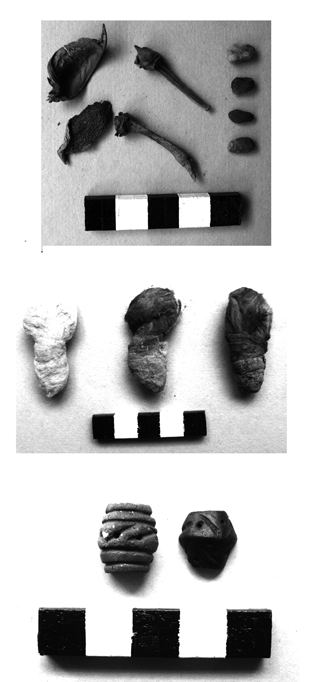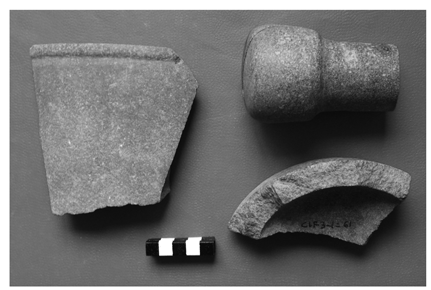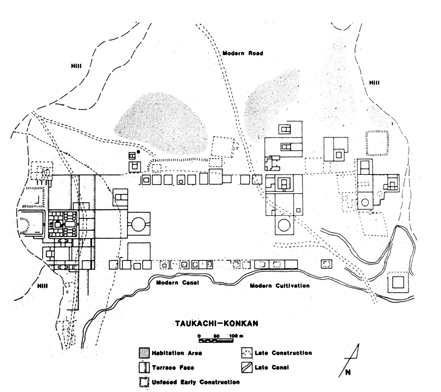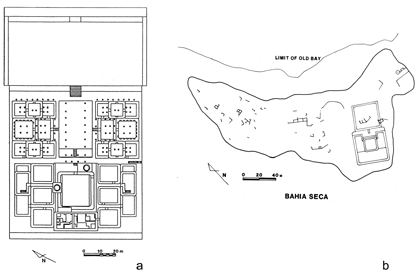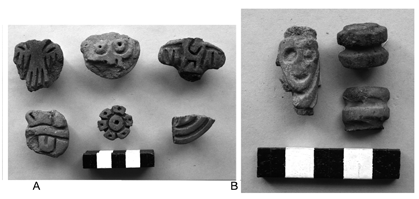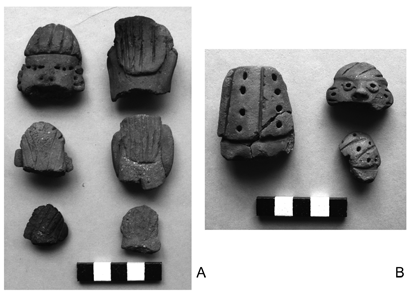CHAPTER FIVE
NEW WORLD BUREAUCRACY AT 1500 BC: EVIDENCE FROM THE CASMA VALLEY OF PERU
Thomas Pozorski and Shelia Pozorski
Introduction
We are especially pleased to be part of this volume because it gives us the chance to exchange ideas with scholars working worldwide on issues concerning bureaucracy, storerooms, and administrative devices. The evidence for our ideas includes regularly laid-out storage structures, stamp and cylinder seals, and other emblems of bureaucratic power. This chapter represents an attempt to put these features in context by first describing the complex polity that occupied the Casma Valley of Peru during the Initial Period (1800–1400 BC). Subsequent sections provide details about storage structures and especially their modular architectural form, which became emblematic of bureaucratic power and control within the polity. These data are followed by descriptions of associated artifacts that may relate to bureaucratic activities.
Sechín Alto Polity Complexity
The Sechín Alto Polity occupied the Casma Valley area for about four hundred years and encompassed both branches of the Casma River and the adjacent coastal zone (Figure 5.1; S. Pozorski and T. Pozorski 1986, 1987, 1992, 2002, 2008; T. Pozorski and S. Pozorski 2005). Major component sites include the following: (1) the four sites of Sechín Alto, Taukachi-Konkán, Sechín Bajo, and Cerro Sechín within the northern Sechín Branch that are grouped into the Sechín Alto Complex based on coincident layout and orientation (Figure 5.2; S. Pozorski and T. Pozorski 1987: 82; 1992: 860); (2) the site of Pampa de las Llamas-Moxeke that dominates the southern, Casma branch of the river; and (3) the three coastal sites of Bahía Seca, Tortugas, and Huaynuná (Figure 5.2). The Sechín Alto Polity exhibits a high degree of social complexity through a variety of tangible measures, including hierarchical relationships among sites; internal site planning; magnitude of corporate labor or public construction; access control; standardization of architecture; and physical remains of plants, animals, and subsistence-related artifacts.
Figure 5.1 Map of the Casma Valley showing the location of early sites.
A multilevel site hierarchy has been cited as an indicator of both social complexity and centralized political organization (Flannery 1998: 16–21; Haas 1982: 103–106; Johnson 1973; Wilson 1988: 87; Wright and Johnson 1975). A site hierarchy of five or more levels is headed by Sechín Alto site with its immense principal mound and numerous subsidiary structures (S. Pozorski and T. Pozorski 2002; T. Pozorski and S. Pozorski 2005). Secondary to this site are Pampa de las Llamas-Moxeke and Taukachi-Konkán, which closely resemble each other in layout. Next are Sechín Bajo and Cerro Sechín, the smallest of the inland sites. Fourth in the hierarchy is Bahía Seca, a coastal administrative center, that likely coordinated resource procurement by the smaller, fifth-level sites of Tortugas and Huaynuná. Hard-to-find field camps and other small sites now obscured by cultivation would have composed a sixth level within this hierarchy.
Precise intrasite planning is evident at all Sechín Alto Polity inland sites. Main mounds and associated plazas exhibit precise bilateral symmetry, and intermediate-sized structures usually face inward and are arranged in rows that follow orientations established by the main-mound central axis. Evidence of planning is especially clear at Pampa de las Llamas-Moxeke, the best-preserved site within the polity (Figure 5.3; S. Pozorski and T. Pozorski 1986, 1987). The central axis of N41°E at the site is established by the mounds of Moxeke and Huaca A that face each other across a series of large plazas. Intermediate-size mounds, other public architecture, and highstatus residential architecture adhere to this orientation, except in the case of mounds oriented toward roads providing access to the site (S. Pozorski and T. Pozorski 1991). Efforts to adhere to the established orientation were so precise that even now, after thousands of years of exposure to the elements, the longest row of mounds diverges only thirty centimeters off a straight line across a distance of more than seven hundred meters. Furthermore, the “master plan” was followed across generations as mounds were constructed in spaces to fill in rows, at times at the expense of residential architecture, which was razed to make space for new construction (S. Pozorski and T. Pozorski 1994).
The single most outstanding feature of the Sechín Alto Polity is the magnitude of its public construction that took the form of flat-topped platform mounds or huacas that supported elaborate summit architecture and large associated plazas. Such manifestations of conspicuous consumption have been cited as universally understood expressions of power (Trigger 1990; Renfrew 1973), and the main mound at Sechín Alto site would seem to be an excellent example. It measures 300 by 250 meters in area and 35 meters tall, making it the largest structure in the New World when it was constructed, about 1500 BC. Some two million cubic meters of stone, cone-shaped adobes, and mortar were put up in only two or three massive construction phases. Facing stones measuring 100 to 150 centimeters on a side and weighing up to 4.5 tons would have involved a well-coordinated labor force to quarry, shape, and transport them to the site (T. Pozorski and S. Pozorski 2012). Other sites also contain large mounds, and our excavations at several of these mounds revealed that they served complementary functions. Moxeke mound at Pampa de las Llamas-Moxeke functioned as a temple, while Huaca A at the same site served as a huge warehouse. The main mound at Taukachi-Konkán was the likely palace or royal residence of the polity ruler, while the main Sechín Alto mound housed both secular administrative areas and a sacred precinct. Large plazas are associated with each of these mounds, especially Moxeke and the Sechín Alto main mound, both of which had massive public-oriented friezes. The four plazas extending out from the main Sechín Alto mound have a combined area of more than 400,000 square meters, and the two large plazas in front of Moxeke mound cover an area of more than 300,000 square meters (Figures 5.2 and 5.3; T. Pozorski and S. Pozorski 2012). Thousands of people could have assembled within the plazas for public demonstrations and ceremonies that cultivated their sense of personal involvement in polity affairs. The unusually strong, powerful, and effective leadership of the Sechín Alto Polity may be attributable to the fact that member sites were bound together through the complementary functions of their component mounds.
The Sechín Alto Polity was supported by a combination of plants cultivated through irrigation agriculture and marine protein derived from the nearby ocean. Inland sites were located at optimum locations for canal intakes and, except for the polity center of Sechín Alto site, were situated outside the limits of prehistoric cultivation. Useful cultivated plants were abundant and varied and included the industrial plants of cotton and gourd and numerous food plants: squash, common beans, lima beans, Canavalia beans, avocado, guava, pacae (a tree legume), lúcuma (a tree fruit), peanut, potatoes, sweet potatoes, and achira (a starchy tuber), but no maize. A subsistence exchange system was in effect whereby the three coastal satellites, under the supervision of Bahía Seca, furnished the inland centers with fish and shellfish in exchange for agricultural products produced by the inland sites (S. Pozorski and T. Pozorski 1987). Anchovies, sardines, and additional larger fish species are prominent among the marine products along with large mussels, scallops, and clams. Clearly the much larger inland sites were the dominant members of this partnership.
Storage within the Sechín Alto Polity
The best evidence for specialized storage structures comes from Pampa de las Llamas-Moxeke where the large mound of Huaca A functioned as a huge warehouse. Its summit, which exhibits four-way symmetry, is covered by thirty-eight examples of a modular room form that we describe as a square-room unit (Figure 5.4; S. Pozorski and T. Pozorski 1992, 1994, 2011). Typical square-room units are near-perfect squares and are characterized by rounded exterior corners; rounded or square interior corners; nine to sixteen high wall niches; floors carpeted with reed matting; and entrances with raised thresholds, paired pilasters that narrow the entrance, and a sliding-bar closure mechanism to further restrict access. What makes these square-room units unique is the modular nature of their construction. Each is a freestanding structure with well-finished interior and exterior walls. Adjacent rooms are often separated by only a few centimeters of space, yet there are no shared walls. Larger “negative” spaces between room modules serve as access corridors as evidenced by their lack of carpeting and wear from foot traffic.
The square-room units, like much formal architecture, were remarkably clean and free of artifacts. Nevertheless, three lines of evidence support our interpretation of Huaca A as a storage structure and the modular square-room units as storerooms. Pollen samples collected from square-room unit floors and niches yielded evidence of cotton, common beans, lima beans, squash, potato, peanuts, and avocado. Lima beans and potatoes in particular produce pollen that does not disperse widely, a further indication that the plants were actually present. A second line of evidence that argues for a storage function for the square-room-unit modules is the presence of thousands of rodent bones on niche and room floors. Remains of rats (Oryzomys sp.) and a few mice (Phyllotis sp.) were very common, often as whole articulated skeletons lying on niche floors, room floors, and on staircases. Based on minimum numbers of individuals from excavated contexts, we estimate that more than five thousand individual rodents may have died on Huaca A. This suggests that problems with these pests were endemic while the huaca was well stocked with food reserves. However, once the site was abandoned and the residual food exhausted, the trapped rodents perished in situ. Finally, some niches contained fragments of cloth. This may indicate that cloth was stored and/or that food or other valuables were stored in cloth containers.
The value of the comestibles and other products stored on Huaca A is reflected by the fact that access to the modular storage facilities was severely restricted (S. Pozorski and T. Pozorski 1994). The “front” entrance of one of the two largest square-room units on Huaca A was barricaded by stacked logs, and all other square-room-unit entrances were narrowed by pilasters and could be blocked by one or more sliding-bar closure mechanisms. These bar-closure mechanisms consisted of pairs of small, generally square, opposing niches, one relatively shallow (ca. fifty centimeters) and the other very deep (often two meters or more; see Figure 5.5). This design allowed a wooden bar to be drawn across the entrance to rest in the shallow niche to impede access or retracted into the deep niche to allow passage through the entrance. The system of bar-closure mechanisms on Huaca A was elaborate and even redundant at times. Where movement between square-room-unit modules involved an elevation change accomplished through stair steps, two bar-closure mechanisms were usually present, aligned vertically but at different heights above the steps. The height of the higher bar was appropriate to stop traffic descending the staircase, whereas the height of the lower bar was appropriate to stop traffic ascending the staircase. Some bar closures could be locked closed through the use of a second bar that was inserted behind the extended bar through a long niche perpendicular to and intersecting the bar-closure niche (Figure 5.5). Redundancy is also evident where two adjacent modules have aligned entrances because both entrances have their own set of pilasters and accompanying bar-closure mechanisms.
Other Square-Room-Unit Modules at Pampa de las Llamas-Moxeke
We believe that the square-room-unit module is much more than a storeroom because its distribution is not confined to Huaca A, and its function is not limited to storage. Many additional examples occur at Pampa de las Llamas-Moxeke and at other Sechín Alto Polity sites where they served varied administrative functions and also likely symbolized polity authority. Seven compounds scattered within the space on either side of Huaca A are actually freestanding square-room units complete with wall niches and bar-closure mechanisms. We interpret these compounds as administrative in function, serving to monitor the flow of goods to and from the Huaca A storage facility (Figure 5.3; S. Pozorski and T. Pozorski 1991).
More than eighty-five additional examples of square-room unit modules form the central rooms of intermediate-size mounds at Pampa de las Llamas-Moxeke. Each mound is like a miniature version of Huaca A, with a central staircase, an atrium, wing rooms, and a single square-room unit at its center. The central square-room units consistently form the tallest part of each mound, and their walls are typically thicker than the walls of associated architecture that abuts but is not bonded into them. All these intermediate-size mounds lie outside the zone of compounds, and most are arranged in rows aligned in accord with the site axis. Exceptions are oriented toward roads that enter the site from the east and west. The aligned mounds probably functioned administratively, possibly to monitor production and transport of goods entering the site from specific locations within the valley, while the roadside mounds may have regulated intersite movement of goods and people (S. Pozorski and T. Pozorski 1987, 1991, 1994). Partial clearing of a sample of these intermediate-sized mounds revealed them to be remarkably clean—without evidence of habitation or ritual activities. Among the few artifacts recovered are fragments of stamp and cylinder seals made of pottery, which may have served an administrative purpose.
At least one square-room unit is also present within the irregular low-status residential architecture on the eastern side of Pampa de las Llamas-Moxeke (Figure 5.6). It forms the center of a full-size administrative structure that likely functioned to oversee cottage industry through which products such as textiles (Figure 5.7) and stone mortars and pestles (Figure 5.8) were manufactured.
Finally, a possible square-room unit or a variant without wall niches forms the central room of the Moxeke mound that faces Huaca A and helps establish the site axis for Pampa de las Llamas-Moxeke. We believe this mound functioned as a temple because of the immense anthropomorphic friezes that once adorned its façade and would have been highly visible from the large plazas in front of the mound. Initially excavated by Tello (1956: 60–64), the square-room unit at the mound center has subsequently been badly damaged by weathering and looting on the mound summit.
The Square-Room-Unit Module at Other Sechín Alto Polity Sites
Outside Pampa de las Llamas-Moxeke, the best-preserved examples of square-room-unit modules were excavated at Taukachi-Konkán within the Sechín Alto Complex (Figure 5.9). Examples are present on the large Mound of the Columns at the west end of the site (Figure 5.10a), which establishes the site axis and as central rooms of intermediate-size mounds facing the site center. Complementing the Moxeke temple and the Huaca A storage structure, the main mound at Taukachi-Konkán is interpreted as a palace or royal residence (S. Pozorski and T. Pozorski 1998; T. Pozorski and S. Pozorski 1999a, 1999b). This function is assigned based on the juxtaposition of a clean, symmetrical, well-plastered, and roofed public area with formal areas suitable for receiving important visitors and a contrasting residential area with an irregular layout, sleeping and sitting platforms, and food remains. Examples of the square-room unit on the Taukachi-Konkán main mound reveal the adaptability of this architectural form. Units identical to examples from Huaca A were likely also used as storerooms—for goods given and received by the royal resident. A nearby variant has low wall niches suitable for use as benches during audiences, thereby serving a more public function.
Excavations have been conducted by other investigators at the Sechín Alto Complex sites of Cerro Sechín and Sechín Bajo where square-room units and variant forms are also present. The central room with painted jaguars at Cerro Sechín is a round-cornered room that apparently lacks niches; and the outer façade, famous for its stone carvings, has a similar form (Collier 1962; Fuchs 1997; Maldonado 1992; Richardson 1994: 69; Samaniego 1973, 1995; Samaniego, Vergara, and Bischof 1985; Tello 1943). Squareroom-unit modules identical to examples at Huaca A have been cleared by Peter Fuchs at Sechín Bajo (Fuchs et al. 2006).
The Sechín Alto site is very similar to both Pampa de las Llamas-Moxeke and Taukachi-Konkán because its main mound establishes the site axis and overlooked a series of plazas bordered by aligned intermediate-size mounds that face the site center. Unfortunately, much of the Initial Period architecture on the mound surface has been destroyed or obscured by later intrusive Early Horizon (1000–200 BC) use of the summit. Nevertheless, excavations that exposed Initial Period architecture revealed that the main Sechín Alto site mound likely functioned as an administrative center. A possible audience area was exposed as well as the remains of a central sacred precinct accessible only by way of a narrow corridor (T. Pozorski and S. Pozorski 2005). Deep excavations within a filled room also revealed a partial square-room unit pertaining to an earlier Initial Period construction phase. Because this architecture was covered by later Initial Period fill, remnants of the original wall colors were preserved, indicating that this square-room unit and nearby associated structures were originally brightly painted in yellow, black, red, and white.
A final example of square-room-unit architecture is present at the coastal site of Bahía Seca (Figure 5.10b) where it forms the central room of an intermediate-sized mound virtually identical to examples at Pampa de las Llamas-Moxeke and other inland Sechín Alto Polity sites (S. Pozorski and T. Pozorski 1992). Like its counterparts at the inland sites, this square-room unit likely functioned administratively. In this capacity, Bahía Seca would have functioned to supervise procurement and possibly processing of marine resources collected by the coastal satellites and to insure their delivery to inland polity centers.
The Square-Room Unit as an Emblem of Control and Polity Authority
Based on the recurring presence and consistent form of the square-room unit and its constant use in administrative contexts within the Sechín Alto Polity, we suggest that this modular architectural form also functioned more broadly as a tangible symbol of the power and control exerted by Sechín Alto Polity leaders. The clear connection of many examples of the square-room unit with storage may reflect the importance of both storage and access limitations to stored commodities as key features of the polity’s power base. Modular square-room units or variants also occur in other administrative contexts, however, such as the audience rooms at Taukachi-Konkán, the compounds near Huaca A at Pampa de las Llamas-Moxeke, and the central rooms at Moxeke and Cerro Sechín. The presence of an intermediate mound with a square-room unit at its center at Bahía Seca on the coast reveals that the “reach” of this icon and the power it symbolized extended well beyond the valley interior.
Taking this idea a step further, we also propose that a set of frequently used symbols within Sechín Alto Polity iconography may depict this standardized architectural form in its capacity as a power symbol. These symbols occur in friezes on Huaca A at Pampa de las Llamas-Moxeke, as part of the warriors’ gear on the carved stone façade of Cerro Sechín, and on a stone mortar fragment from a private collection.
We have interpreted the frieze within the north atrium of Huaca A as a pair of immense jaguars facing each other across the principal entrance to the mound (Figure 5.11; S. Pozorski and T. Pozorski 1992). On either side of the entrance, and immediately in front of each jaguar, is a pair of prominent circular designs. The central part of this design is a circle with four rectangles spaced evenly around its perimeter (Figure 5.11a). We believe this design is a depiction of the square-room unit, with its wall niches represented by the evenly spaced rectangles. In this context, as part of the polity iconography, the square-room unit modular architectural form is abstracted into an emblem of power and authority. The frieze within the south atrium of Huaca A is poorly preserved, but enough remains to determine that it is different from the north frieze (T. Pozorski and S. Pozorski 1993). Within the iconography, however, are three designs that may represent the square-room-unit power symbol. The shape of the south-frieze symbols is more square with rounded corners so that the form looks more like a square-room unit; the rectangles, believed to represent niches, are well within the borders rather than at the perimeter.
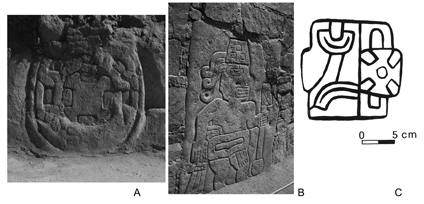
We have also identified possible square-room-unit power symbols on the carved stone façade of Cerro Sechín within the Sechín Alto Complex (Cárdenas 1995). Circles with perimeter rectangles there are virtually identical to the Huaca A north atrium examples. They form the lower end of the staffs or clubs held by most of the intact figures generally interpreted as warriors (Figure 5.11b). At least sixteen Cerro Sechín warriors carry these clubs (Moseley 1992: 142) and occupy prominent positions within the procession of beings and body parts depicted on the façade, including positions flanking both the front and rear entrances to the square-room-unit module variant decorated by the carvings.
A final example of iconography containing the square-room-unit power and authority symbol documents its use on portable media and brings together the symbols of power and ruling personages. This depiction is on a stone mortar fragment from a private collection, reported to be from the Pan de Azúcar sector of the Casma Valley (Figure 5.11c; León 1995: figs. 2, 4). On this mortar, the power symbol comprises the right half of a dual design. The left half is a partial face with a wide vertical band crossing the eye zone. This form of facial decoration is commonly seen on important personages within Casma, including the Cerro Sechín warriors (Cárdenas 1995) and one of the colossal faces that adorn the Moxeke mound at Pampa de las Llamas-Moxeke (Tello 1956: fig. 31). The dual image on the mortar seems to represent a melding of the power symbol with the actual personage who wielded power.
Artifacts and Bureaucracy
Two classes of artifacts may be associated with the activities of the far-reaching bureaucracy of the Sechín Alto Polity. These include both cylinder and stamp seals as well as figurines—all made of fired clay. More than a dozen examples of seals were recovered from administrative contexts at Pampa de las Llamas-Moxeke, where they were likely used, and from midden contexts within the Sechín Alto Complex, where they were likely manufactured.
Both types of seals were made using a combination of modeling and incision, and both types show a wide range of variation (Figure 5.12). The only duplication is a pair of stamp seals with an S-shaped design (S. Pozorski and T. Pozorski 1986). Other fragmentary examples are geometric, one intact example resembles a flower, and another may be a bird, while several others seem representational, but their designs cannot be discerned. Cylinder seals also exhibit both abstract and representational designs. One abstract example would have produced parallel horizontal lines, while another would have been used to apply a repetitive pattern with faces. Red pigment residue is still present within the grooves of several examples of both types, indicating they were used to apply this substance, perhaps to textiles or human skin. This makes the Casma Valley examples different from Near Eastern versions, which were locks used primarily to impress designs in soft clay (Collon 1990; Rothman and Fiandra, Chapter 2, this volume). Nevertheless, the cylinder and stamp seals apparently served the same purpose as those in the Near East—as symbols of authority and ownership (Collon 1990: 11; Foster and Foster 2009: 25; Lloyd 1987: 39; Maisels 2003: 146).
Human figurines are more numerous and consistent in form than the stamp and cylinder seals (S. Pozorski and T. Pozorski 1998). More than four hundred fragments have been recovered from Sechín Alto Polity sites (Figure 5.13; T. Pozorski and S. Pozorski 2012). These solid hand-modeled androgynous figures are typically twelve to fifteen centimeters tall, and their features were created using incision, punctation, and appliqué. Eyes are formed by making a deep horizontal incision, inserting a bead of clay to form the eyeball, and adding a deep punctation for the iris. Ears are modeled or attached as appliqué, and internal features are defined by incision and punctation (earhole). Noses are modeled or applied separately, and deep punctations define the nostrils, while mouths are made by a series of deep horizontal punctations. The two options for head treatment include fez-like caps and appliqué locks of long hair defined by incision. Appliqué bands decorated with punctations and incisions form collars at the head/torso join. Belts or loincloths, defined by appliqué and/or incision, are occasionally present in the abdomen area. The chest is always bare, with the arms are folded across the torso. Perforations under both armpits of most figures may have served to suspend the figures or attach them to something. Legs are always conjoined and defined front and back by deep incisions that may extend across the figure’s base to separate the feet. Four toes are usually demarcated on each foot by single incised lines. Figurine bases are uniformly flat or concave so that the figures stand well.
Elements of the figurines’ features can be related to Sechín Alto Polity iconography at both Cerro Sechín and Moxeke at Pampa de las Llamas-Moxeke. The figurines with caps and belts or loincloths may represent the same personages as the Cerro Sechín stone carvings of warriors, who wear similar clothing and caps, and these in turn may connect with the colossal heads at Moxeke because of similar face paint. The bareheaded figurines, in contrast, may connect with the bare-headed victims with prominent hair at Cerro Sechín, who can be related to the large standing figures at Moxeke based on their clothing, which is characterized by pleated skirts and scalloped tunics. Taken collectively, the iconography of the Sechín Alto Polity reflects bureaucracy both literally and figuratively. Based on clothing, face paint, and hairstyles, it is possible to distinguish two groups of important personages. One type is depicted in the standing figures of Moxeke, the victims at Cerro Sechín, and possibly the bare-headed figurines, while the second is represented by the colossal heads of Moxeke, the warriors at Cerro Sechín, and the figurines with fez-like caps. The prominence and frontal pose of the standing figures on the Moxeke temple, a religious structure (Tello 1956), contrasts with the warlike attributes and stance of the Cerro Sechín warriors (Cárdenas 1995), suggesting that the two groups may have had distinct functions and power bases within Sechín Alto Polity society. More abstractly, the high degree of standardization of the figurines and the Cerro Sechín carvings also documents the far-reaching impact of Sechín Alto Polity bureaucracy because artistic license was apparently quite limited.
Conclusions
In this chapter, we have attempted to highlight both similarities and differences between Andean examples of bureaucracy as represented in the archaeological record and examples from other parts of the world. Many features are comparable, including the construction of monumental architecture, the use of large areas of storerooms to which access was restricted (T. Pozorski and S. Pozorski 2012) and the use of devices such as seals that relate to bureaucratic activities. However, the Sechín Alto Polity within the Casma Valley took most of these concepts to an extreme. The polity overbuilt its monumental architecture to create platform mounds without rival in the New World. There is no obvious ecological explanation for the magnitude of Sechín Alto Polity development, so we must look internally to understand its Initial Period florescence. Several factors appear critical to the polity’s success. Evidently a strong, charismatic leadership emerged who was likely inspired by similar but earlier Preceramic manifestations of social complexity and power in valleys to the south (Haas and Creamer 2004, 2006; Haas, Creamer, and Ruiz 2004, 2005; Ruiz, Creamer, and Haas 2007; Shady 1997, 2001, 2006, 2007a, 2007b; Vega Centeno et al. 1998). Borrowing ideas of structure symmetry, mounds with associated plazas, irrigation agriculture, and coastal/inland subsistence exchange, Sechín Alto Polity leaders used their preconceived plan to create a more elaborate and advanced society within the Casma Valley. Feelings of rivalry may help explain the magnitude of construction within Casma because similar political units appeared in most north coast valleys at about this time (Ruiz, Creamer, and Haas 2007).
The heavy hand of Sechín Alto Polity leadership is readily evident. Sechín Alto site, the polity capital, asserts its power by both the magnitude of its construction and its location on arable land. Precise planning is also evident among sites of the Sechín Alto Complex as manifested by their shared orientation and within individual sites as evidenced by symmetry and layouts that are quite similar from site to site. These preconceived site plans were transmitted through several generations as revealed by Pampa de las Llamas-Moxeke, where rows of aligned mounds were constructed and filled in, often at the expense of extant residential architecture, which was destroyed in the process. Within each component site, the square-room-unit architectural form served tangibly for storage and, by extension, for administration associated with products and their storage. However, this modular architectural form also became an icon that symbolized the power behind the leadership of the Sechín Alto Polity. The presence of square-room-unit modules within residential zones characterized by cottage industry documents, efforts to control production, and polity iconography appears similarly restricted. Such overall standardization in architecture, artifacts, and iconography reflects restricted norms with respect to artistic expression.
But how were Sechín Alto Polity leaders able to exert such control and motivate citizens to create such impressive public works? The presence of square-room-unit modules at Bahia Seca and in contexts related to intersite movement and storage of comestibles at Pampa de las Llamas-Moxeke suggests that control of subsistence may have been critical. These stored commodities may have given polity leaders leverage as they assembled and provided for large work forces. At the same time, the immense plazas and public-oriented friezes at polity sites document the complementary role of community involvement and inspiration connected with public events and ceremonies. Furthermore, the complementary functions of the major mounds at component polity sites—as the polity administrative center, as a temple, as a warehouse, and as a palace—would have fostered a strong sense of social solidarity and polity unity because each component clearly served a vital role. This constructed interdependence among components enabled the entire Sechín Alto Polity to function as a highly unified social, political, and economic entity rather than as a collection of discrete sites and was likely critical to its effectiveness. Based on the Casma Valley example, it seems necessary to examine both commonalities and differences among societies with well-developed bureaucracies in order to more fully understand the development and maintenance of these complex societies worldwide.
References
Cárdenas, Mercedes. 1995. Iconografía Litica de Cerro Sechín: Vida y Muerte. In Arqueologíade Cerro Sechín,Tomo II: Escultura, ed. Lorenzo Samaniego and Mercedes Cárdenas, 43–124. Lima: Pontificia Universidad Católica del Perú and Fundación Volkswagenwerk.
Collier, Donald. 1962. Archaeological Investigations in the Casma Valley, Peru. Thirty-Fourth International Congress of Americanists 35: 411–417.
Collon, Dominique. 1990. Near Eastern Seals. Berkeley: University of California Press.
Flannery, Kent. 1998. The Ground Plans of Archaic States. In Archaic States, ed. Gary Feinman and Joyce Marcus, 16–57. Santa Fe: School of American Research Press.
Foster, Benjamin, and Karen Foster. 2009. Civilizations of Ancient Iraq. Princeton: Princeton University Press.
Fuchs, Peter. 1997. Nuevos datos arqueométricos para la historia de ocupación de Cerro Sechín—Período Lítico al Formativo. In Aqueológica Peruana 2: Arquitectura y civilización en los Andes prehispánicos, ed. Elizabeth Bonnier and Henning Bischof, 145–162. Mannheim: Sociedad Arqueológica Peruano-Alemana, Reiss-Museum.
Fuchs, Peter, Renate Pazschke, Claudia Schmitz, Germán Yenque, and Jesús Bruceño. 2006. Archaeological Research at Sechín Bajo, Casma. In Procesos y Expresiones de Poder, Identidad y Orden Tempranos en Sudamérica. Boletín de Arqueología PUCP10, ed. Peter Kaulicke and Tom Dillehay, 111–135. Lima: Pontificia Universidad Católica del Perú.
Haas, Jonathan. 1982. The Evolution of the Prehistoric State. New York: Columbia University Press.
Haas, Jonathan, and Winifred Creamer. 2004. Cultural Transformations in the Central Andean Late Archaic. In Andean Archaeology, ed. Helaine Silverman, 35–50. Malden, MA: Blackwell Publishing.
Haas, Jonathan, and Winifred Creamer. 2006. Crucible of Andean Civilization, the Peruvian Coast from 3000 to 1800 BC. Current Anthropology 47: 745–775.
Haas, Jonathan, Winifred Creamer, and Álvaro Ruiz. 2004. Dating the Late Archaic Occupation of the Norte Chico Region in Peru. Nature 432: 1020–1023.
Haas, Jonathan, Winifred Creamer, and Álvaro Ruiz. 2005. Power and the Emergence of Complex Polities in the Peruvian Preceramic. In Foundations of Power in the Prehispanic Andes, ed. K. J. Vaughn, D. Ogburn, and C. A. Conlee, 37–52. Washington, DC: American Anthropological Association.
Johnson, Gregory. 1973. Local Exchange and Early State Development in Southwestern Iran. Ann Arbor: Museum of Anthropology, University of Michigan Anthropological Papers 51.
León, Wilder. 1995. Un Mortero de Piedra con Motivo Sechín en Casma. In Arqueología de Cerro Sechín. Tomo II: Escultura, ed. Lorenzo Samaniego and Mercedes Cárdenas, 247–255. Lima: Pontificia Univesidad Católica del Perú.
Lloyd, Seton. 1987. The Archaeology of Mesopotamia. New York: Thames and Hudson.
Maisels, Charles. 2003. Early Civilizations of the Old World. New York: Routledge.
Maldonado, Elena. 1992. Arqueología de Cerro Sechín.TomoI: Arquitectura. Lima: Pontificia Universidad Católica del Perú and Fundación Volkswagenwerk.
Moseley, Michael E. 1992. The Incasand Their Ancestors. London: Thames and Hudson.
Pozorski, Shelia, and Thomas Pozorski. 1986. Recent Excavations at Pampa de las Llamas-Moxeke, a Complex Initial Period Site in Peru. Journal of Field Archaeology 13: 381–401.
Pozorski, Shelia, and Thomas Pozorski. 1987. Early Settlement and Subsistence in the Casma Valley, Peru. Iowa City: University of Iowa Press.
Pozorski, Shelia, and Thomas Pozorski. 1991. Storage, Access Control, and Bureaucratic Proliferation: Understanding the Initial Period (1800–900 BC) Economy at Pampa de las Llamas-Moxeke, Casma Valley, Peru. Research in Economic Anthropology 13: 341–371.
Pozorski, Shelia, and Thomas Pozorski. 1992. Early Civilization in the Casma Valley, Peru. Antiquity 66: 845–870.
Pozorski, Shelia, and Thomas Pozorski. 1994. Multidimensional Planning at Pampa de las Llamas-Moxeke. In Meaningful Architecture, ed. Martin Locock, 45–65. Avebury: Worldwide Archaeological Series 9.
Pozorski, Shelia, and Thomas Pozorski. 1998. La Dinámica del Valle de Casma durante el Período Inicial. In Perspectivas Regionales del Período Formativoen el Perú, Boletín de Arqueología PUCP 2, ed. Peter Kaulicke, 83–100. Lima: Pontificia Universidad Católica del Perú.
Pozorski, Shelia, and Thomas Pozorski. 2002. The Sechín Alto Complex and Its Place within Casma Valley Initial Period Development. In Andean Archaeology I: Variations in Sociopolitical Organization of the Central Andes, ed. Helaine Silverman and William Isbell, 21–51. New York: Kluwer Academic/Plenum Publishers.
Pozorski, Shelia, and Thomas Pozorski. 2008. Early Cultural Complexity on the Coast of Peru. In Handbook of South American Archaeology, ed. Helaine Silverman and William Isbell, 604–631. New York: Springer.
Pozorski, Shelia, and Thomas Pozorski. 2011. The Square-Room Unit as an Emblem of Power and Authority within the Initial Period Sechín Alto Polity, Casma Valley, Peru. Latin American Antiquity 22: 1–25.
Pozorski, Thomas, and Shelia Pozorski. 1993. Early Complex Society and Ceremonialism on the Peruvian North Coast. In El Mundo CeremonialAndino, ed. Luis Millones and Yoshio Onuki, 45–68. Osaka: National Museum of Ethnology.
Pozorski, Thomas, and Shelia Pozorski. 1999a. Temple, Palais ou Entrepôt? La Centralisation du Pouvoir dans le Pérou Préhistorique. In Ville et Pouvoir en Amérique: les Formes de l’Autorité, ed. Jérôme Monnet, 87–110. Paris: L’Harmattan.
Pozorski, Thomas, and Shelia Pozorski. 1999b. La Centralización del Poder en el Perú Prehispánico Temprano. Revista del Museo de Arqueología, Antropología e Historia 7: 87–109.
Pozorski, Thomas, and Shelia Pozorski. 2005. Architecture and Chronology at the Site of Sechín Alto, Casma Valley, Peru. Journal of Field Archaeology 30: 143–161.
Pozorski, Thomas, and Shelia Pozorski. 2012. Preceramic and Initial Period Monumentality within the Casma Valley of Peru. In Early New World Monumentality, ed. Richard L. Burger and Robert Rosenswig, 364–398. Gainesville: University Press of Florida.
Renfrew, Colin. 1973. Monuments, Mobilization and Social Organization in Neolithic Wessex. In The Explanation of Culture Change: Models in Prehistory, ed. Colin Renfrew, 539–558. London: Duckworth.
Richardson, James B. 1994. People of the Andes. Washington, DC: Smithsonian Books.
Ruiz, Álvaro, Winifred Creamer, and Jonathan Haas. 2007. Investigaciones Arqueológicas en los Sitio del Arcaico Tardío (3000 a 1800 años a.C.) del Valle de Pativilca, Perú. Barranca: Instituto Cultural del Norte Chico.
Samaniego, Lorenzo. 1973. Los Nuevos Trabajos Arqueológicos en Sechín, Casma, Perú. Trujillo: Larsen Ediciones.
Samaniego, Lorenzo. 1995. La Escultura del Edificio Central de Cerro Sechín. In Arqueología de Cerro Sechín, Tomo II: Escultura, ed. Lorenzo Samaniego and Mercedes Cárdenas, 19–41. Lima: Pontificia Universidad Católica del Perú and Fundación Volkswagenwerk.
Samaniego, Lorenzo, Enrique Vergara, and Henning Bischof. 1985. New Evidence on Cerro Sechín, Casma Valley, Peru. In Early Ceremonial Architecture in the Andes, ed. Christopher B. Donnan, 165–190. Washington, DC: Dumbarton Oaks Research Library and Collection.
Shady, Ruth 1997. La Ciudad Sagrada de Caral-Supe en los Albores de la Civilización en el Perú. Lima: Universidad Nacional Mayor de San Marcos.
Shady, Ruth. 2001. La Ciudad Sagrada de Caral-Supe y los Orígenes de la Civilización Andina. Lima: Museo de Arqueología y Antropología de la Universidad Nacional Mayor de San Marcos.
Shady, Ruth. 2006. La Ciudad Sagrada de Caral-Supe: Símbolo Cultural del Perú. Lima: Instituto Nacional de Cultura.
Shady, Ruth 2007a. The Sacred City of Caral-Supe: Cultural Symbol of Peru. Lima: Instituto Nacional de Cultura.
Shady, Ruth. 2007b. The Social and Cultural Values of Caral-Supe, the Oldest Civilization of Peru and the Americas, and Their Role in Integrated Sustainable Development. Lima: Instituto Nacional de Cultura.
Tello, Julio. 1943. Discovery of the Chavín Culture in Peru. American Antiquity 9: 135–160.
Tello, Julio. 1956. Arqueología del Valle de Casma, Culturas: Chavín, Santa o Huaylas Yunga y Sub-Chimú, vol. 1. Lima: Universidad Nacional Mayor de San Marcos.
Trigger, Bruce. 1990. Monumental Architecture: A Thermodynamic Explanation of Symbolic Behaviour. World Archaeology 22: 119–132.
Vega-Centeno, Rafael, Luis Villacorta, Luis Cáceres, and Giancarlo Marcone. 1998. Arquitectura Monumental Temprana en el Valle Medio de Fortaleza. Boletín de Arqueología PUCP 2: 219–238.
Wilson, David. 1988. PrehispanicSettlement Patterns in the Lower Santa Valley Peru. Washington, DC: Smithsonian Institution Press.
Wright, Henry, and Gregory Johnson. 1975. Population, Exchange, and Early State Formation in Southwestern Iran. American Anthropologist 77: 267–289.
